The Paramount Duet has been on the scene for donkey’s years. It was, in fact, one of the earliest caravans to incorporate fold-out bed-ends. Sure, retractable beds had been fitted to campers going back to the 1970s, but caravans? If I’m not mistaken, it wasn’t until the turn of the millennium that this design made its way to the big brothers of the RV world, courtesy of a WA-based manufacturer.
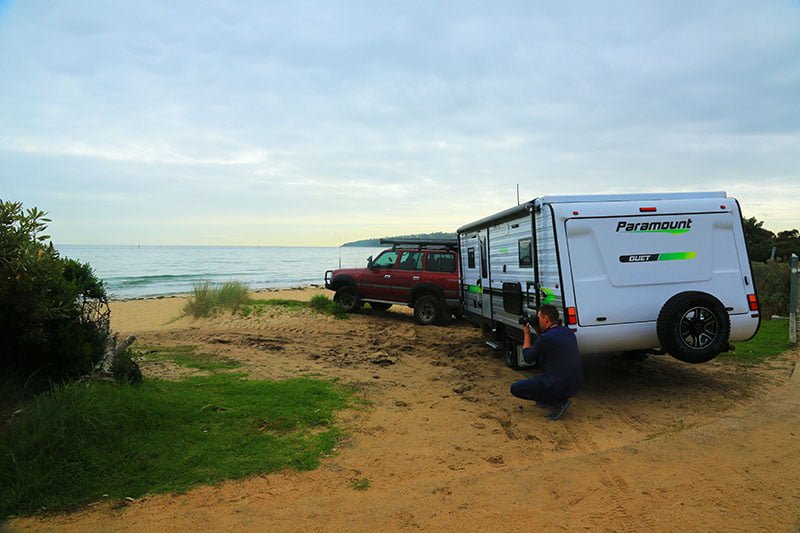 Now, it seems every man and his dog offers fold-out beds. And why not? They’re a convenient, practical answer to the question of space in a caravan. Pity the person who forgot to patent the concept.
Now, it seems every man and his dog offers fold-out beds. And why not? They’re a convenient, practical answer to the question of space in a caravan. Pity the person who forgot to patent the concept.
But Paramount has been doing it longer than most. And it still does it well.
SETTING IT UP
Our review Duet, supplied to us by Canterbury Caravans in Bayswater, Vic, is a single-axle pop-top known as the 18ft Long Lounge. It has a 4in drawbar and chassis with 2in raiser, independent Dexter Torflex suspension rated to 2.4 tonnes, a ball coupling, and dual gas cylinders. Oh, and a long lounge inside.
Over the years, the procedure for setting up a Duet hasn’t really changed. First, you’ll need to raise the pop-top roof. Undo each over-centre corner clasp, set the roll-out awning to ‘open’, and head inside. Because this Duet was fitted with the wall-mounted Heron Q reverse-cycle air-conditioner, the roof was quite effortless to lift (heavy roof-mounted air-cons add somewhat to the difficulty factor).
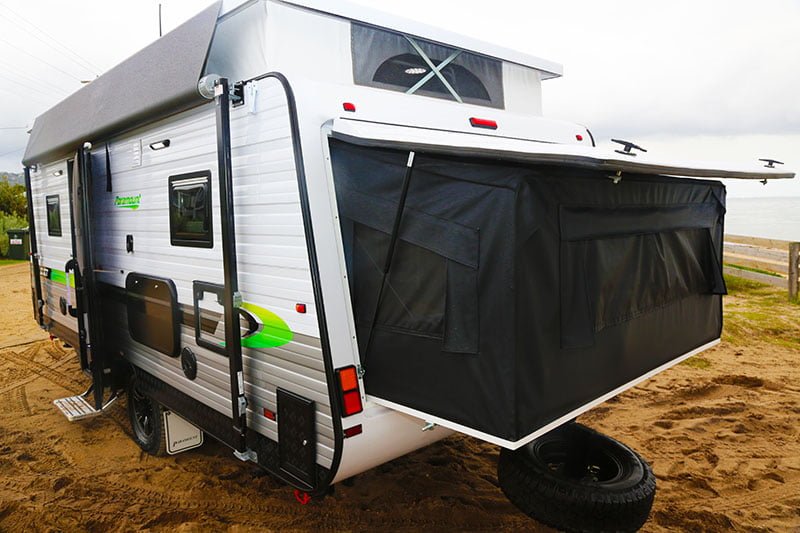 A couple of catches hold the fibreglass bed ‘lids’ in place, and once released, the lids rise on gas struts to become a hard roof over the canvas bed enclosures.
A couple of catches hold the fibreglass bed ‘lids’ in place, and once released, the lids rise on gas struts to become a hard roof over the canvas bed enclosures.
The ply bed base is held in place by a large sliding bolt. Once the bolt is retracted, the bed base lowers easily enough. Then, inside, you’ll need to raise a hinged steel-tube ‘hoop’, which rests on the ply base when the bed is closed but holds the canvas in place when the bed is opened. Two horizontal, telescopic tensioning bars per bed also need to be fitted. Admittedly, it’s a slightly fiddly process, but no more so than the aforementioned campers.
The Duet’s spare tyre is mounted to a special carrier at the rear of the van. This carrier has to be lowered before the rear bed can be set-up. A removable steel pin keeps the carrier vertical when the van is under tow.
EXTERNAL FEATURES
There was a range of options added to our review Duet by Canterbury Caravans, the dealership I borrowed it from. A 100Ah deep-cycle battery and an external ‘entertainment hatch’ lined with marine carpet are among them. The entertainment hatch comprises 12V and 240V points and an antenna point, but a TV mount isn’t included – you’d want to rest your telly on the nearby fold-out picnic table.
The dealer-added options were included at the factory, when the van was built, rather than afterwards. Therefore, the weight of these options are factored into the Tare of the pop-top.
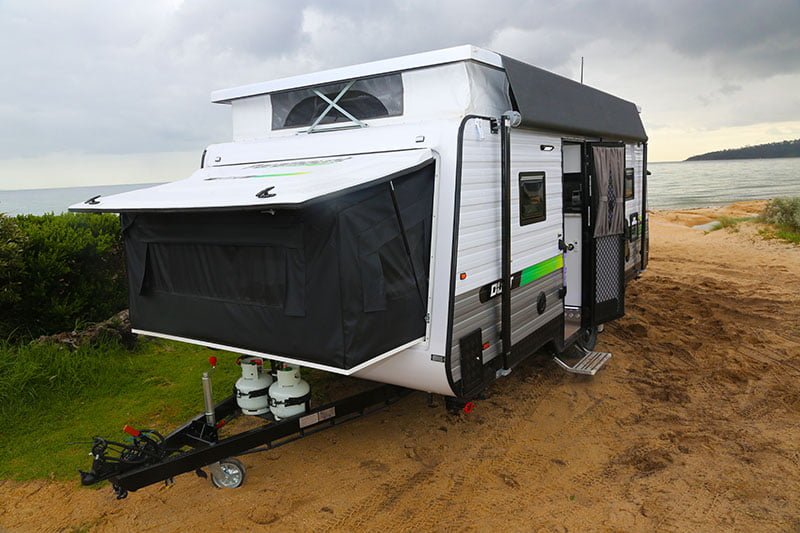 On the offside, you’ll find a hatch to access the Projecta battery charger and 12V fuses, as well as a hatch for front tunnel storage that can be accessed from under the bed. The nearside also has front tunnel storage access, as does the rear nearside. These tunnels are somewhat narrow, though. Having said that, there is some storage space behind the beds when they’re packed away.
On the offside, you’ll find a hatch to access the Projecta battery charger and 12V fuses, as well as a hatch for front tunnel storage that can be accessed from under the bed. The nearside also has front tunnel storage access, as does the rear nearside. These tunnels are somewhat narrow, though. Having said that, there is some storage space behind the beds when they’re packed away.
A brass tap is fitted to the offside of the drawbar, but I reckon it would benefit from a stoneguard. A curved piece of checkerplate would do the job.
INNER BEAUTY
Without question, the Duet has a lot of wow factor. I couldn’t help but be impressed by the inner workings of this van. The quality of finish to Paramount vans seems to have come a long way in recent times, and it was on show here. Don’t get me wrong: there was nothing inherently wrong with previous Paramounts, but the company has lifted the fit and finish, and seems to be paying more attention to the details.
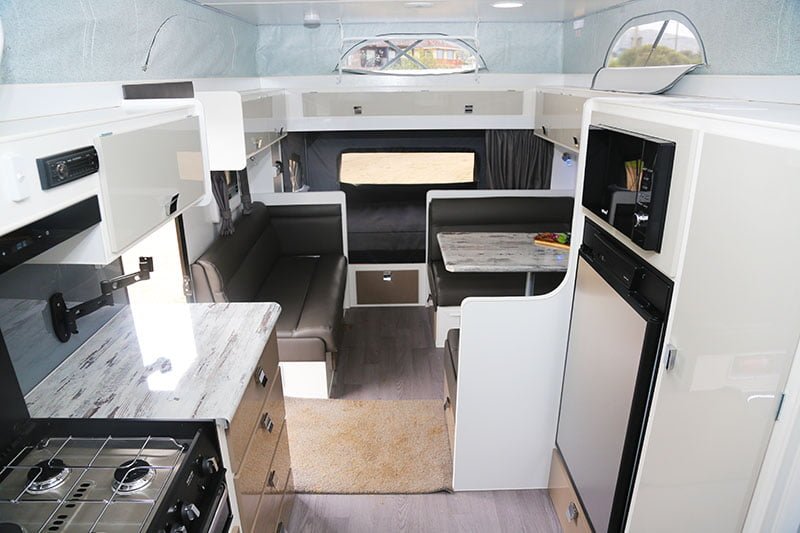 The result is an almost-immaculate interior, with CNC-cut cabinetry featuring glossy doors on seemingly sturdy hinges, the drawers on metal runners. And everywhere you look, there’s storage. That’s what happens when a manufacturer doesn’t try to shoe-horn in a bathroom – there’s space for other important features.
The result is an almost-immaculate interior, with CNC-cut cabinetry featuring glossy doors on seemingly sturdy hinges, the drawers on metal runners. And everywhere you look, there’s storage. That’s what happens when a manufacturer doesn’t try to shoe-horn in a bathroom – there’s space for other important features.
The offside dinette transforms quickly into an extra bed by removing the table’s pole and resting the tabletop onto timber edges that are fixed to the dinette’s seat bases. Squeeze the included foam infill into place and, presto, a place for your unexpected guest to sleep.
I appreciated the fact that drawers were fitted to the under-seat areas of the dinette lounges, too. Hands up if you’re sick of wrestling of seat cushions to access this area?
Opposite the dinette is the van’s namesake ‘long lounge’, a two-seater to the left of the entry where you’d spend lazy, sunny afternoons reading your favourite book. There’s heaps of storage underneath, too, but no drawer to access it. Fortunately, because there’s no table in the way, it’s not awkward to remove the cushion to get your gear.
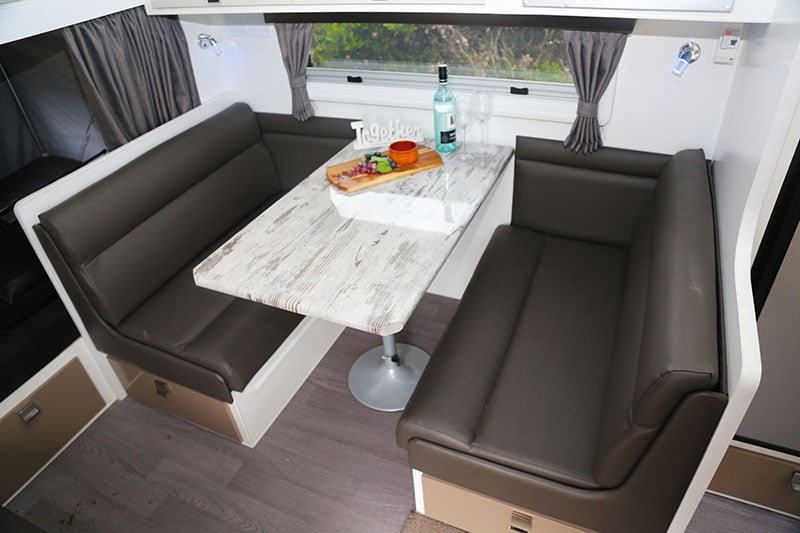 Behind the dinette, you’ll find a Thetford fridge-freezer, and behind that a suite of storage options, including a full-height pantry, wardrobe, a few drawers and other storage options. A couple of mirrors have been included here. This might sound rather trivial but you’d be surprised how often a simple mirror is overlooked by caravan manufacturers.
Behind the dinette, you’ll find a Thetford fridge-freezer, and behind that a suite of storage options, including a full-height pantry, wardrobe, a few drawers and other storage options. A couple of mirrors have been included here. This might sound rather trivial but you’d be surprised how often a simple mirror is overlooked by caravan manufacturers.
The kitchen is similarly well endowed with storage. Cupboards, drawers, overhead lockers. I could go on.
Among the other features of this van, there’s a water level indicator, DVD/CD player, USB charging points, multi-directional reading lights and other 12V lighting options throughout. It’s very neatly presented, indeed.
GORV’S VERDICT
Weighing a shade over two tonnes fully loaded, with a payload capacity of 300kg, this Duet has it pretty much figured out. Ultimately, while it might spend a night or two away from civilisation, it’s destined to spend more nights in caravan parks and the like.
When the water tank and gas cylinders are full, you’ll still have almost 200kg to work with. That being the case, and considering this Duet isn’t designed for extensive remote touring, a greater payload is probably not necessary. It towed well, too, as I’ve come to expect from vans built by Paramount.
Are there things I’d change or include? Well, I’d look into fitting a hot water service, even though it would slightly erode the onboard storage options, as well as an external shower. When free camping, the 95L of onboard water wouldn’t last long if you were to use the shower, but when hooked up to town water and conserving every last drop wasn’t such an imperative, the ability to wash sand off your feet without trudging to the amenities makes all the difference. In my opinion, at least.
In the Duet 18ft Long Lounge, Paramount Caravans has built an attractive, practical van for long-term adventures around Australia.
THE SCORE
FIT AND FINISH – 
LAYOUT – 
INNOVATION – 
HITS & MISSES
COMPLETE SPECS
Overall length: 7.4m
External cabin length: 5.58m
External cabin width: 2.44m
Travel height: 2.5m (including optional ‘medium ranger’ hatch; 2.35m without hatch)
Internal height: 1.98m
Tare: 1730kg
GTM: 1890kg
ATM: 2030kg
Unladen ball weight: 140kg
Frame: Meranti timber
Cladding: Aluminium
Coupling: Ball
Chassis: 4in galvanised steel with 2in raiser
Suspension: Independent Dexter Torflex
Brakes: 12in electric
Wheels: 15in alloy
Fresh water: 1x95L
Awning: Dometic roll-out
Battery: 100Ah deep-cycle (with Anderson plug)
Solar: Provision
Air-conditioner: Heron Q
Gas cylinders: 2×4.5kg
Sway control: Optional
Cooking: Thetford Mini Grill MkIII four-burner cooktop and griller
Refrigeration: Thetford 128L three-way fridge/freezer
Microwave: Yes
Toilet: No
Shower: No
Washing machine: No
Lighting: 12V LED
Hot water: Optional
Full-height pantry; 100Ah deep-cycle battery; Winegard antenna; ‘medium ranger’ hatch (clear hatch in the roof); acrylic splashbacks; external entertainment locker; external speakers
$49,998 ($46,087 base price)





